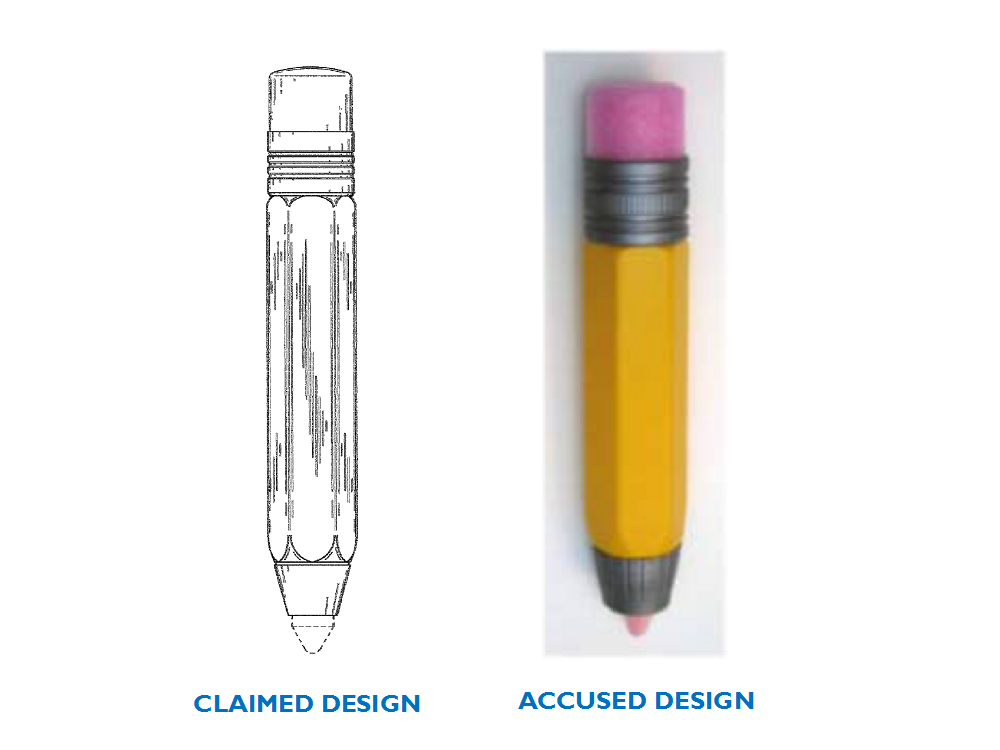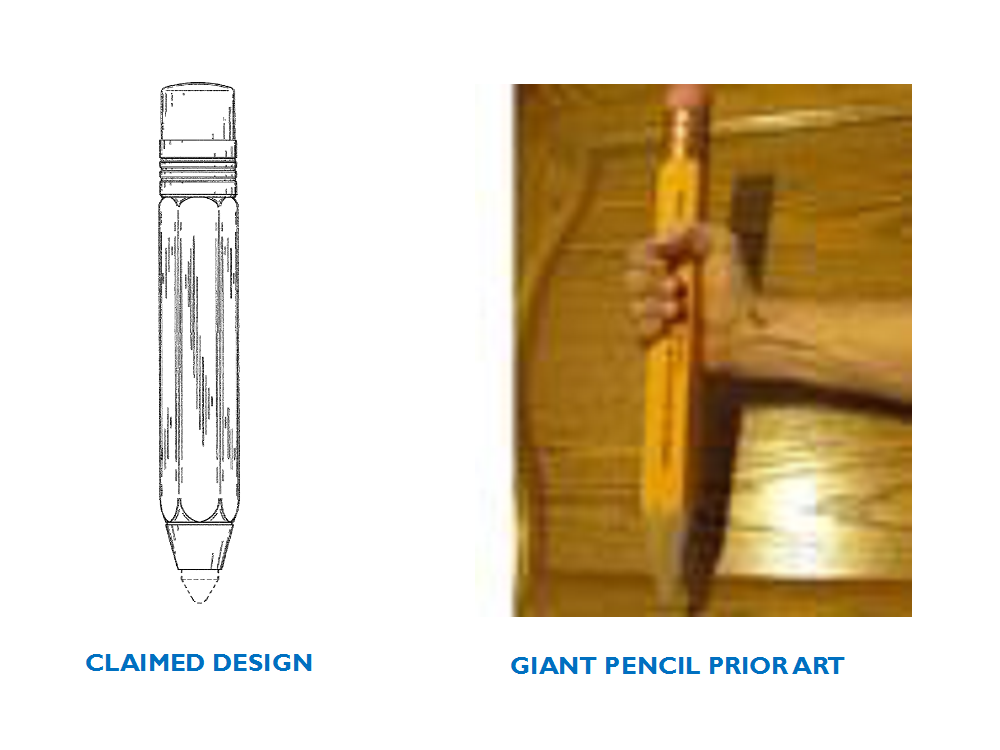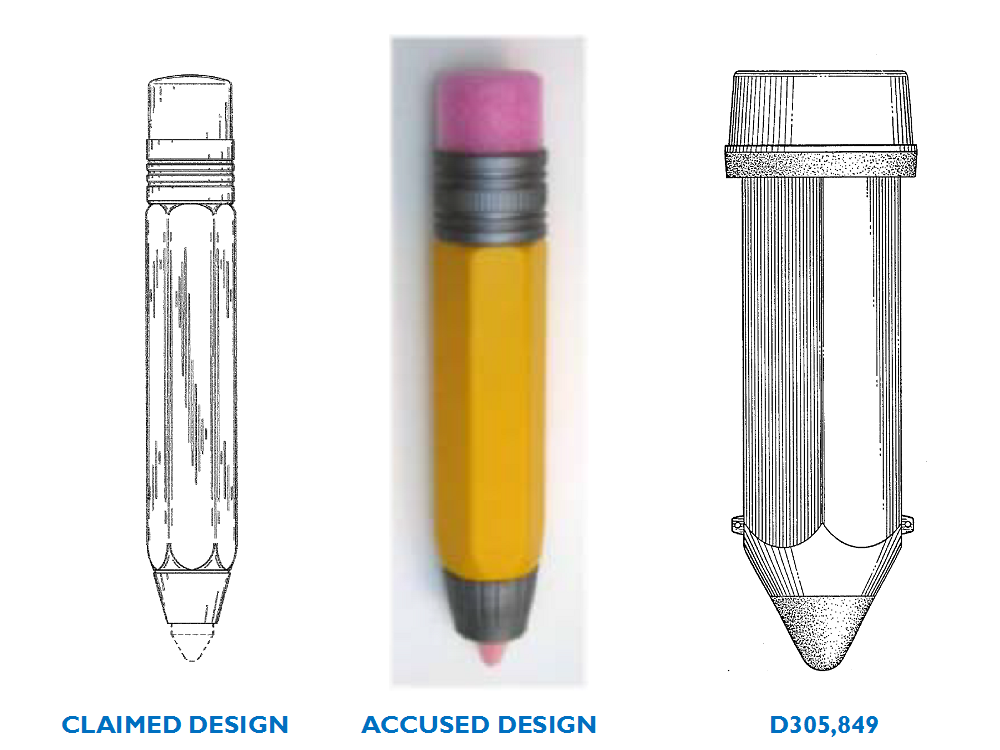In Lanyard Toys Limited v. Toys “R” Us (March 21, 2019, MD FL), a district court in the middle district of Florida made a somewhat dysfunctional analysis in finding that Lanyard’s U.S. Pat. No. D671,167 was not infringed by Toys R Us.
The design patent was on a chalk holder resembling a #2 pencil. The chalk holder was short and stubby, and had an aperture in the bottom (rather than lead) for chalk to be inserted. The product was intended for use by children as a toy.
Toys R Us sold a similar chalk holder, which differed from the patented design in what can be characterized as relatively minor features. Following is the design patent shown next to the accused design.

Regarding claim construction, the court said that Lanard heavily relied on “the chalk holder function of its design as the overriding point of similarity between the patented design and accused design that is absent from the prior art.” This is an echo from the old “point of novelty” test that was abolished by the Federal Circuit in the seminal Egyptian Goddess case.
The court essentially decided to completely discount the facts that both designs were chalk holders, that the patent title/claim specifically recited CHALK HOLDER, and apparently there were no toy-like chalk holders in the prior art. The court interpreted Lanard’s position as relying on the “function” of the design, a position it rejected saying that Lanard was assuming that the patent examiner issued the ‘167 patent “based on the new function of the design, rather than its unique appearance”. In a very convoluted analysis, the court relied on a series of ancient decisions to support this, starting with the 1893 Supreme Court’s Whitman Saddle case, all of which had to do with validity rather than infringement.
The court, after going to some lengths to discount the title and claim of the patent, then assumed “without deciding” that there was no infringement, saying it was ignoring “the distinct functions of [the prior art] devices”, in lieu of focusing on the differences in the ornamental features.
In then considering infringement, the court also relied upon the discredited Richardson case, saying that “the conceptual elements of the design and their particular configurations are functional”. The court is correct in that design patents cannot cover general concepts, but incorrect in relying on the functionality of the “particular configurations” to exclude same from its claim construction & infringement analysis.
The court listed the following differences between the patented and claimed designs:
1. The proportions are different;
2. The ‘167 design is more slender and elongated, while the defendant’s chalk holder has a “thicker, more stunted, appearance”;
3. The appearance of the conical tapered portion of the designs are distinct; and
4. “perhaps most prominently” the appearance of the ferrules in each design is different.
Lanard relied on similar proportions of the patented and accused designs to establish infringement. The court rejected this, saying that the relative size and thickness of the designs as compared to no. 2 pencils is a “functional modification necessary to accomplish the chalk holder function of the devices”. As found time and again in recent Federal Circuit decisions such as Ethicon & Sport Dimension, every utilitarian feature has an associated appearance that must be used to compare to the prior art and accused design; the shape of the utilitarian features cannot be ignored or discounted. Moreover, it seems to be a stretch to say that a “chalk holder” is a functional feature. It’s simply the article of manufacture embodying the design, as required by MPEP 1503.01. All articles of manufacture must have utilitarian features in order to qualify as design patentable subject matter, 35 U.S.C. 171.
Finally, the court incorrectly said that “the overall proportions of the patented design are similar to the [prior art] Giant Pencil as they are to the accused design”. If one was to compare the proportions of those two designs, the Giant Pencil (shown below) has an aspect ratio (length to diameter) close to 10, while that of the claimed design is around 7.

The accused design has an aspect ratio which is closer to 5. Another prior art reference of record, an Insulating Container of U.S. Pat. No.D305,849 also has an aspect ratio of about 5, making its proportions much more similar to the claimed design and accused designs. A comparison of the claimed design, the accused design, and the closest prior art, the ‘849 patent is instructive:

One can easily appreciate that the accused design is closer in appearance to the claimed design than either is to the closest prior art, i.e., the ‘849 patent. This makes a finding of infringement more likely than not, despite the minor differences between the patented and accused designs, which the Federal Circuit many years ago in the Litton case found were insufficient to avoid infringement.
As a parting shot, the court said that to ignore the dissimilarities in comparing the patented and accused designs “would improperly broaden the scope of Lanard’s patent to include all chalk holders that incorporate a pencil design” – an absurd conclusion.
Maybe the convoluted analysis in this case will spur a call for the jurisdiction of the PTAB to expand to include design patent infringement cases. I have recently reviewed all PTAB decisions involving design patents, and can say with confidence that the PTAB’s analysis of design patent claim constructions and invalidity contentions is 95% correct. Thus, design patentees should not be reluctant to have the Board take infringement determinations under its wing. Other countries have specialized patent courts to decide infringement, and this case points to the not atypical confusion of the federal district courts who only infrequently – if ever – handle a design patent case.
